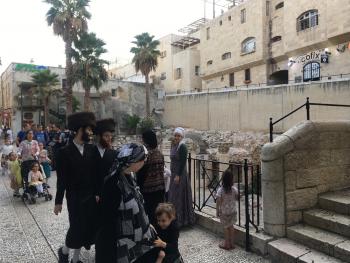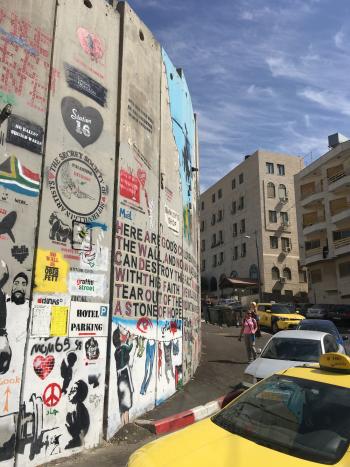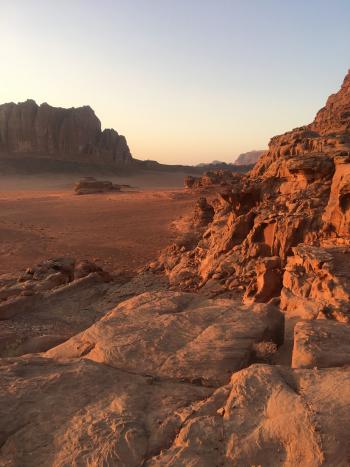Exploring the history and diversity of Israel, Jordan and the West Bank
This article appears on page 20 of the March 2018 issue.
My wife, Kerry Hutchinson, and I spent 10 days in Israel, the West Bank and Jordan in late September-early October 2017, undaunted by the news of terrorist attacks and recent conflict. We felt very safe during our trip, even in the West Bank. One key prudent step, as is the case anywhere in the world, is to avoid protesting crowds if you happen upon them. However, we saw none while we were there.
As with most of my trips, my planning utilized Lonely Planet country guides, articles in the archives of the ITN website (www.intltravelnews.com), information on UNESCO World Heritage Sites found online (whc.unesco.org/en/list), Hillman’s Top 1000 Wonders of the World website (www.hillmanwonders.com/top_1000/index.htm) and comments about guides and hotels in my destination cities rated highly on TripAdvisor.com.
This turned out to be a great time to visit. The climate was in the upper 70s with little rain, and the summer crowds had dissipated. There are lots of Jewish holidays at that time of year, but we easily hopped over to nearby Jordan for a few days to escape the nearly complete shutdown of Israel during Yom Kippur.
Jerusalem
Jerusalem is a city unlike any other. In a compact one-third square mile, you will find some of the holiest sites of Christianity, Judaism and Islam, encircled by a 16th-century Ottoman wall. The city is filled with an amazing diversity of Christian pilgrims, Arabs and Jewish immigrants from all over the world.
Kerry and I stayed in the Old City to experience this ancient city more intimately, and we had easy access to this special place. All the sites of interest were just outside our door.
Our accommodation choice was a private Airbnb studio property called Legatia (www.airbnb.com/rooms/15545613), located in the Jewish Quarter. It cost $145 a night and had a very helpful manager, Magrit.
On our first full day we sprung for a private guide, which is my favorite way to splurge when traveling overseas. Our guide, Itay Shevach (itayshevach@gmail.com), was exceptional. For eight hours, he charged $400. Itay tailored the day around our requests, supplemented by his own recommendations.
We saw the Church of the Holy Sepulchre, where you can enter the cave where, reputedly, Christ’s body was laid to rest and from which He later rose from the dead; the Western Wall, the 1st-century-BC wall of the Jewish Second Temple; the Temple Mount, and the location where the Last Supper is said to have happened.
In addition, we toured the City of David, thought to be the location of ancient Jerusalem, which the Israelis have impressively transformed into a world-class archaeological site.
Given the cost of hiring a private guide, we spent the next day on our own, finding it easy to navigate Jerusalem using its streetcars and taxis and with the assistance of numerous people we met who spoke English.
We went to the emotionally powerful World Holocaust Remembrance Center (www.yadvashem.org) and the open-air food market, Machane Yehuda, and explored nearby neighborhoods.
West Bank
We wanted to hear another perspective of life in Israel, so we took a Palestinian-guided tour of the West Bank, selecting one offered by Green Olive Tours (Jaffa, Israel, phone, in the US, 612/276-2077, www.greenolivetours.com).
Their Bethlehem tour ($85 per person) included a visit to a striking 5th-century Greek monastery in the desert; the “separation wall,” covered in protest paintings, including some by British graffiti artist Banksy; a great little museum on the conflict between the Israelis and Palestinians; the Church of the Nativity, reputedly built on the location of Christ’s manger, and a UN-run Palestinian refugee camp, which looked like just a regular set of apartment blocks until we saw the spent shells of Israeli tear gas littered along the street.
It was disheartening to hear our Palestinian guide give his perspective on why peace remains so elusive.
Since Bethlehem is only about 15 miles from Jerusalem, this was an easy day trip, which returned us to Jerusalem’s YMCA, an impressive Art Deco building where I recommend having a relaxing drink and snack after the tour.
Border crossings
Then came our trickiest day, logistically. We left Jerusalem at 7 a.m. with a taxi arranged by our Airbnb manager for a prenegotiated rate of $85. We arrived in Tel Aviv at 9:30 a.m. for a wonderful tour of the world’s largest collection of Bauhaus architecture.
Our private guide, Yigal Gawze (yigal@telavivbauhauswalk.com), took us on a 2½-hour walking tour ($170) that would be intriguing for anyone with even a passing interest in architecture.
We were shocked at how different the city and people of Tel Aviv were compared to those of Jerusalem. The former was a thriving modern metropolis that could easily fit into any Western country, while the latter was a 2,000-year-old walled city filled with many deeply religious people.
After our Bauhaus tour, we headed off to Tel Aviv’s airport, where I experienced the most intense security check of my life. The security official pulled West Bank souvenirs from our luggage, asking us to explain why we obtained them and if we were sympathetic to Arabs. It was unsettling, and I strongly encourage you not to pack anything too controversial. (For example, I almost took a spent tear gas shell as a souvenir but was, fortunately, talked out of it by my wife.)
Then we boarded our flight for an easy 50-minute trip to Eilat, Israel’s southernmost city. Upon landing, we took a 10-minute taxi ride to the Jordanian border crossing.
We walked through the crossing, with its somewhat confusing exit process on the Israeli side and similarly confusing entry process on the Jordanian side. It helped to ask officials for guidance, and they were glad to provide the instructions that were missing from the signs and forms.
The process was fast, as our guidebook promised, taking just 30 minutes, in contrast to the two to three hours that the border crossing can take closer to Jerusalem.
Jordan
Fortunately, we had prearranged for a driver to meet us on the Jordanian side of the border, as there was no taxi stand there. Our private driver in Jordan, Suzan Gabor (jordanzsu@gmail.com), a Hungarian woman, was with us from the time we crossed the border until four days later, when we crossed back into Israel.
She was a good driver, though she was not a guide. We paid $150-$175 a day for her services. (The cost was bundled with the cost of our hotels, so this is an estimate.)
We spent our first night in Aqaba, a resort/industrial town on the Red Sea, just a 10-minute ride from the Israeli border crossing.
We stayed at the 5-star InterContinental ($180 per night), where we enjoyed swimming in the ocean at sunset near the hotel’s groomed beach. Then we had a great Lebanese dinner, one of our best meals in Jordan, at the hotel ($30 per person, including an appetizer, entrée, wine and dessert).
In the morning we headed off to Wadi Rum, a beautiful, UNESCO-designated desert preserve where “Lawrence of Arabia” once amassed his armies to fight the Ottomans. We hopped into a very rough, open jeep with a local Bedouin driver, who took us to see huge sand dunes, natural rock arches and petroglyphs. We ended up at a tented camp run by his brother, where we spent a rustic night that included a campfire dinner under the stars.
The next day we went to Petra, an impressive site built by the Nabataeans as a series of monuments and aqueducts, dating mostly from the 3rd century BC to the 1st century AD.
You can walk 10 to 15 miles touring the site, so wear good walking shoes. If you’re interested, a well-trained and sanctioned guide can be retained for $50 at the entrance. I had hired a different guide, arranged through my driver, and if I had to do it over again, I would use one of the official guides from the visitors’ center.
We stayed at the Mövenpick hotel ($175 per night), an excellent 5-star property located just across from the entrance to the site. That night, we had a great Jordanian dinner, just a few blocks from the hotel, at the Three Stairs Restaurant ($35 for the two of us).
Our third full day in Jordan consisted of lots of driving. We started with a visit to Umm ar-Rasas, a Roman-Byzantine ruin that was, by far, the worst UNESCO World Heritage Site I have experienced, This poorly explained (and maintained) site is not worth a visit, in our opinion. Also included in the day’s itinerary were Mount Nebo and the 12th-century Crusader fort, Shobak Castle.
Dead Sea stop
The highlight was our last stop, where we swam in the Dead Sea, which is so buoyant that I walked out into the waters, standing fully upright, even when my feet no longer touched the bottom.
We stayed at the Dead Sea Spa Hotel ($100 per night), a somewhat antiquated 3-star resort. Looking back, I should have spent more to stay at a better hotel and hired a guide for the day, as the sites displayed limited information.
On our last day in Jordan, we toured the impressive Baptism Site, a UNESCO World Heritage Site. This location is where John the Baptist putatively baptized Christ and now where thousands of Christians get rebaptized each day. The site is just a few miles from the border crossing back to Jerusalem.
As our guidebook warned, the crossing back to Israel took us nearly three hours. We finally arrived back in Jerusalem, where we paid $140 for an overnight in the modern portion of the city at the Dan Boutique Jerusalem (www.danhotels.com), a great 4-star hotel with a very helpful staff, before taking a taxi the next morning to Tel Aviv for our flight home. It had been a great 10 days.




